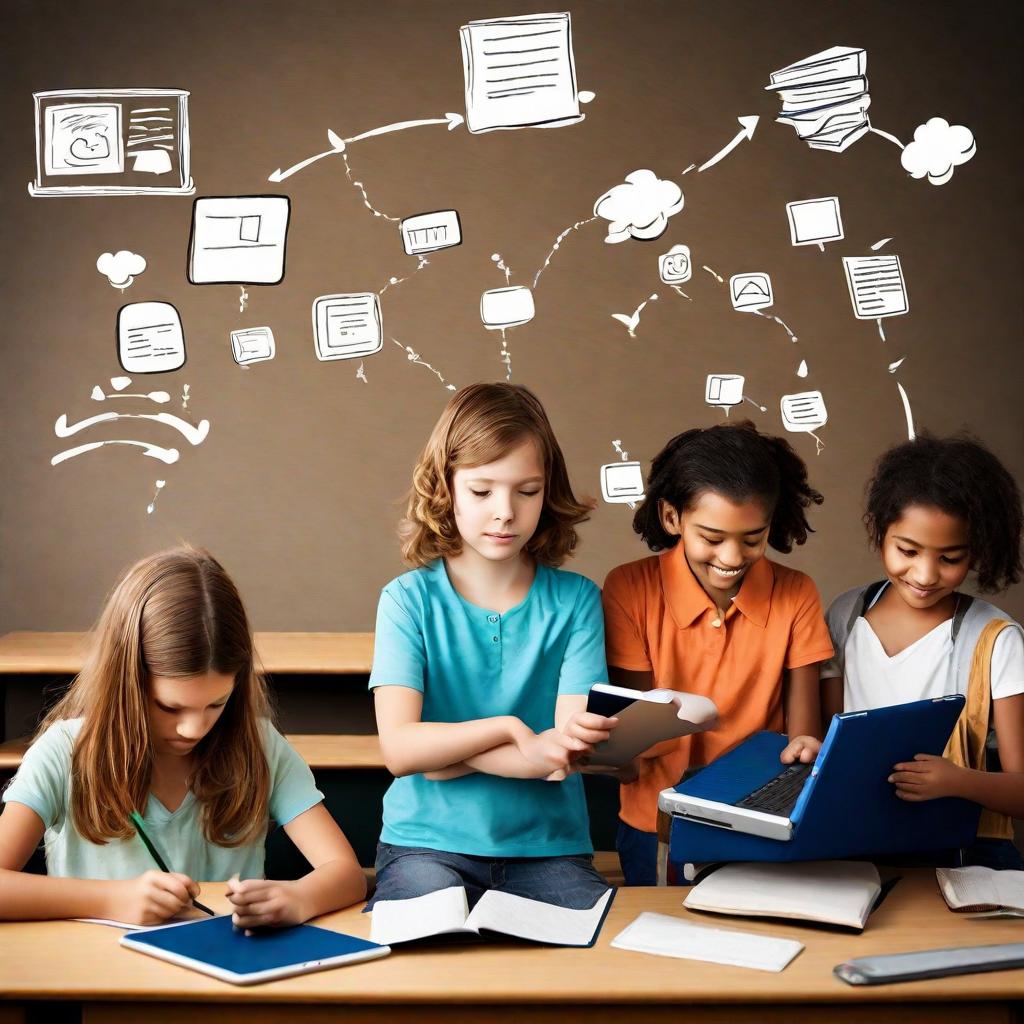Revolutionizing Education: The Impact of Technology on Learning
In today’s rapidly evolving world, traditional education models are being disrupted by the integration of technology. This transformative shift is revolutionizing the way we teach and learn, offering endless possibilities for educational advancement. By embracing technology, educators can enhance teaching methods, bridge gaps for equal opportunities, and create an inclusive and future-ready learning environment. This blog post aims to explore the impact of technology on learning and its potential to revolutionize education for the better.
I. Understanding the Need for Transforming Education
Education systems worldwide are facing significant challenges that call for innovative solutions. The traditional lecture-based approach often fails to engage students fully, resulting in decreased participation and limited learning outcomes. To overcome these hurdles, there is a pressing need for transformation in education – and technology holds the key to unlocking these possibilities.
II. Enhancing Teaching Methods with Technology
A. Interactive Learning: Fostering Engagement and Participation
Interactive learning methodologies leverage technology to actively engage students in the learning process, fostering a sense of curiosity and exploration. Technology offers various tools and platforms that reshape education and make learning a fun and interactive experience.
1. Gamification: Making Learning Fun and Interactive
Gamification integrates game elements into educational activities, motivating students with rewards, challenges, and friendly competition. By transforming tedious tasks into interactive games, gamification boosts engagement, enhances problem-solving skills, and promotes healthy competition.
2. Virtual Reality: Creating Immersive Educational Experiences
Virtual Reality (VR) technology enables students to explore immersive educational experiences that are otherwise challenging to replicate in a traditional classroom environment. From virtual field trips to historical simulations, VR provides an innovative way to enhance learning by making it experiential and memorable.
3. Collaborative Online Platforms: Facilitating Peer Learning
Technology bridges the gap between students and encourages collaborative learning through online platforms. These platforms enable students to engage with their peers, share ideas, and work together on projects. Collaborative learning fosters critical thinking, communication, and teamwork skills, preparing students for the demands of the modern workforce.

B. Personalized Education: Tailoring Learning Experiences
Every student has unique learning needs, and technology allows for personalized education that caters to individual strengths, weaknesses, and interests. By leveraging technology, educators can create tailored learning experiences that maximize the potential of each student.
1. Adaptive Learning Systems: Catering to Individual Needs
Adaptive learning systems utilize algorithms and AI to analyze student performance and deliver personalized content and feedback. This approach allows students to learn at their own pace and receive targeted support in areas where they need it most, ensuring efficient and effective learning.
2. Artificial Intelligence in Education: Customizing Curricula
Artificial Intelligence (AI) in education is transforming the way curricula are designed and delivered. AI-powered tools can analyze student data, identify knowledge gaps, and develop customized learning paths. By tailoring curricula to individual student needs, AI enhances learning outcomes and ensures a more comprehensive and personalized educational experience.
3. Data-Driven Insights: Empowering Teachers to Address Students’ Needs
Technology generates vast amounts of data that provide valuable insights into student progress and engagement. Educators can utilize this data to identify struggling students, pinpoint areas for improvement, and provide targeted interventions. Data-driven insights empower teachers to make informed decisions and adapt their teaching strategies to meet the diverse needs of their students.
C. Blended Learning: Combining Traditional and Digital Approaches
Blended learning combines traditional classroom instruction with online resources and digital tools, offering a comprehensive and flexible learning experience that caters to different learning styles and preferences.
1. Flipped Classroom Model: Enhancing Student Engagement
The flipped classroom model reverses the traditional learning structure by delivering lectures online and using class time for interactive activities. This approach allows students to engage with content at their own pace and fosters active participation and collaboration during face-to-face sessions.
2. Online Resources: Expanding Access to Educational Materials
Technology expands access to a vast array of online educational resources, including e-books, interactive tutorials, and educational videos. These resources provide students with additional learning materials, support self-paced learning, and offer supplementary content that enriches the learning experience.
3. Synchronous and Asynchronous Learning: Offering Flexibility
Synchronous learning involves real-time interaction between students and instructors, while asynchronous learning provides flexibility by allowing students to access course materials and participate in discussions at their convenience. Blended learning combines both approaches, enabling students to learn at their own pace while still benefiting from direct interaction with their peers and educators.
III. Bridging Gaps for Equal Opportunities
Despite the advancements in education, significant gaps persist, limiting access to quality education for many individuals. Technology has the potential to bridge these gaps and ensure equal opportunities for all learners.
A. Overcoming Geographical Barriers through E-Learning
1. Remote Learning: Accessing Quality Education Anywhere
E-learning provides students in remote areas with access to quality education that was previously inaccessible. By connecting students with educators and resources globally, technology removes the limitations imposed by geographical barriers, ensuring that everyone has the opportunity to learn and grow.
2. Online Courses and Massive Open Online Courses (MOOCs)
Online courses and MOOCs offer affordable or even free access to high-quality educational content from leading institutions worldwide. These virtual learning platforms provide an opportunity for individuals to learn at their own pace, acquire new skills, and enhance their knowledge without the constraints of time or location.
3. Bridging the Rural-Urban Divide: Widening Educational Access
Technology plays a crucial role in bridging the educational gap between rural and urban areas. By providing online resources, connecting rural schools to urban centers, and equipping educators with the necessary digital tools, technology enables students in rural areas to access the same educational opportunities as their urban counterparts.
B. Digital Divide: Ensuring Equal Access for All Students
While technology offers tremendous potential for educational advancement, the digital divide hinders equal access and opportunity. Efforts are underway to address this divide and ensure that all students have equal access to technology and the benefits it brings.
1. Affordable Devices and Connectivity: Bridging the Gap
Initiatives aimed at providing affordable devices and internet connectivity to underserved communities are essential in narrowing the digital divide. By ensuring that students have access to the necessary technology, schools can level the playing field and empower all learners to thrive in the digital age.
2. Digital Literacy: Empowering Students for the Digital Age
To bridge the digital divide effectively, students need not only access to technology but also the skills and knowledge required to navigate the digital world. Digital literacy programs provide students with the necessary skills to use technology safely, responsibly, and effectively, ensuring that they can fully participate in the digital age.
3. Technology Grants and Public Initiatives: Eliminating Disparities
Grants and public initiatives aimed at providing schools in underserved communities with technology resources are crucial in eliminating disparities. By investing in infrastructure and resources, policymakers can ensure that all students have equal access to technology and the opportunities it provides.
C. Empowering Marginalized Learners through Assistive Technology
Assistive technology enables individuals with disabilities or learning differences to overcome barriers and actively participate in the learning process. By leveraging technology, educators can create inclusive learning environments that empower marginalized learners.
1. Accessibility Tools: Enabling Inclusive Education
Accessibility tools, such as screen readers, speech recognition software, and adaptive keyboards, help students with disabilities navigate and engage with technology. By incorporating these tools into classrooms, educators ensure that all students can access and participate in educational activities.
2. Adaptive Devices: Supporting Students with Disabilities
Adaptive devices, such as hearing aids, braille displays, and mobility devices, empower students with disabilities to overcome challenges and actively participate in educational activities. Through technology, educators can create learning environments that cater to the diverse needs of all students.
3. Multilingual Learning: Facilitating Language Acquisition
Technology facilitates multilingual learning by providing language learning software, translation tools, and resources that enable students to acquire new languages. By embracing technology, educators can foster language acquisition and create inclusive and culturally diverse classrooms.
IV. Evolving Education Infrastructure
As technology continues to transform education, it is essential to adapt the education infrastructure to support these changes effectively.
A. Updating Curriculum for the Digital Age
To prepare students for the challenges of the digital age, curricula need to be updated to include essential digital literacy skills, critical thinking, problem-solving, and an emphasis on STEM subjects.
1. Digital Citizenship and Online Safety: Nurturing Responsible Internet Use
Digital citizenship education equips students with the knowledge and skills needed to navigate the digital world responsibly. By educating students about online safety, privacy, and responsible online behavior, educators prepare them to be responsible digital citizens.
2. Critical Thinking and Problem-Solving: Building Future-Ready Skills
Critical thinking and problem-solving skills are vital for success in the digital age. By incorporating these skills into curricula through project-based learning and real-world problem-solving activities, educators prepare students to navigate complex challenges and adapt to a rapidly changing world.
3. Coding and STEM Education: Preparing Students for Technological Careers
Coding and STEM education foster computational thinking, creativity, and problem-solving skills, preparing students for future careers in technology. By integrating coding and STEM education into curricula, educators equip students with the skills needed to thrive in an increasingly digital and tech-driven world.
B. Upskilling Educators in Technology Integration
For technology to be effectively utilized in the classroom, educators need to be equipped with the necessary skills and knowledge to integrate technology into their teaching practices.
1. Professional Development: Equipping Teachers for Technological Challenges
Professional development programs provide educators with the training and support they need to effectively integrate technology into their classrooms. By offering opportunities for ongoing learning, educators can stay updated with the latest technological advancements and effectively leverage them for educational purposes.
2. Pedagogical Shifts: Emphasizing Active Learning and Collaboration
Technology integration requires a shift in pedagogical approaches towards active learning and collaboration. Educators need to adopt student-centered learning strategies that leverage technology to foster collaboration, critical thinking, and problem-solving skills.
3. Teacher-Student Partnership: Fostering Continuous Learning
Technology allows for a dynamic partnership between teachers and students. Educators can encourage students to take ownership of their learning, explore new ideas, and provide feedback on educational tools and resources. This collaborative approach fosters continuous learning and empowers students to become active participants in their education.

C. Evaluating the Impact of EdTech: Balancing Benefits and Concerns
As technology becomes more deeply integrated into education, it is essential to evaluate its impact on learning outcomes, student well-being, and individual privacy.
1. Assessing Learning Outcomes: Measuring the Impact of Technology
Evaluating the impact of educational technology on learning outcomes involves analyzing student performance, engagement, and progress. By collecting and analyzing data, educators can identify the strengths and limitations of edtech and make informed decisions about its integration into their classrooms.
2. Mindful Technology Use: Addressing Screen Time and Distractions
While technology offers immense benefits, it is important to ensure mindful use. Educators should address concerns about excessive screen time and potential distractions that may hinder learning. By setting boundaries and promoting responsible technology use, students can maximize the benefits of technology without compromising their well-being and focus.
3. Ethical and Privacy Considerations: Safeguarding Student Information
As data collection becomes more prevalent in education, it is crucial to prioritize student privacy and data security. Educators and policymakers must establish robust safeguards and ethical guidelines to protect student information and ensure that technology integration prioritizes student well-being and learning outcomes.
V. Conclusion
Technology has the potential to revolutionize education by enhancing teaching methods, bridging gaps for equal opportunities, and evolving the education infrastructure. By embracing technology in the classroom, educators can create engaging, personalized, and inclusive learning environments that prepare students for the challenges of the digital age. As we look to the future of education, it is imperative that we continue to promote equity and inclusion, ensuring that all students have access to the transformative power of technology. Embracing the opportunities technology presents while addressing the associated challenges will pave the way for a brighter and more inclusive future of learning.




